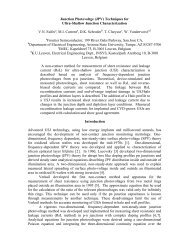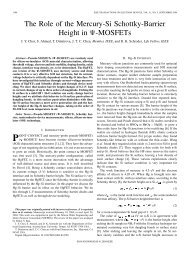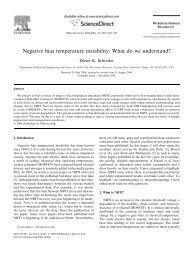ECS Transactions 3, (4), 321-337 (2006) - Dieter Schroder - Arizona ...
ECS Transactions 3, (4), 321-337 (2006) - Dieter Schroder - Arizona ...
ECS Transactions 3, (4), 321-337 (2006) - Dieter Schroder - Arizona ...
Create successful ePaper yourself
Turn your PDF publications into a flip-book with our unique Google optimized e-Paper software.
<strong>ECS</strong> <strong>Transactions</strong> 3, (4), <strong>321</strong>-<strong>337</strong> (<strong>2006</strong>)<br />
In the novel RsL non-contact sheet resistance and leakage current measurement technique,<br />
modulated, above band gap light illuminates the surface junction and creates electron-hole<br />
pairs. 8 The internal photoelectron effect separates the carriers and they drift out<br />
of the region under the light beam, governed by the sheet resistance, R sh , of the upper<br />
layer of the junction.<br />
Two ac-coupled electrodes ~1 mm above the junction measure the spatial extent of<br />
carrier spreading. One electrode, V 1 , is directly over the area, illuminated by the light<br />
beam, and the other, V 2 , is a short distance away in the dark, shown in Fig. 2(a). The ratio<br />
of the junction photo-voltage signals collected by the two electrodes is determined by the<br />
junction sheet resistance, leakage current, and capacitance, which are separately determined<br />
in the RsL method. An RsL map is shown in Fig. 2(b).<br />
Minority Carrier Lifetime, Defects<br />
Surface photovoltage (SPV) is, of course, a well established technique. A major application<br />
of SPV is the measurement of iron in boron-doped silicon. The method relies on dissociating<br />
Fe-B pairs and measuring the minority carrier diffusion length before and after<br />
dissociation. Recent advancements allow determination of iron densities as low as 10 8<br />
cm -3 . The iron density is given by 9 ⎛<br />
16 1 1 ⎞<br />
−3<br />
N 1.06 10 ⎜ ⎟<br />
Fe<br />
= × − cm<br />
[1]<br />
2 2<br />
⎝ Lnf<br />
Lni<br />
⎠<br />
where L nf and L ni are the final and initial diffusion lengths in µm. As the iron density in Si<br />
wafers decreases to 10 9 cm -3 and below, it becomes more difficult to determine N Fe for<br />
several reasons. The SPV analysis is generally based on the assumption that the sample<br />
be about 3L n or more thick. This requires very thick samples with increasing diffusion<br />
lengths. For example, for N Fe =10 9 cm -3 , L ni ≈1000 µm, requiring samples thicknesses of ~<br />
3 mm. Several precautions must be addressed for low iron density samples. The SPV signal<br />
decreases with decreasing N Fe . The sample temperature must be accurately known as<br />
the optical absorption coefficient varies with temperature. Since the Fe-B pair dissociation<br />
is done by light flashes, it is important to keep these as short as possible not to<br />
change the sample temperature. The Si surface is sometimes treated with an HF-based<br />
solution to create a surface barrier to collect the minority carriers. This surface barrier<br />
changes with time and this influences the SPV signal. Interstitial iron formed by Fe-B<br />
dissociation, forms Fe-B again with the time constant<br />
5<br />
4.3×<br />
10 T ⎛ 0.68 ⎞<br />
τ<br />
pairing<br />
= exp⎜<br />
⎟<br />
[2]<br />
N<br />
A ⎝ kT ⎠<br />
Obviously, the SPV measurements should be made before appreciable pair formation.<br />
Hence the measurement time after Fe-B dissociation and after surface treatment must be<br />
kept short. Signal averaging also helps for low-level signals. If all of these considerations<br />
are taken into account, it is possible to detect iron densities ~10 8 cm -3 or even lower. 10<br />
Quasi-Steady-State Photoconductance An important addition to the array of lifetime<br />
characterization techniques is quasi steady-state photoconductance (QSSPC). 11 The sample<br />
is illuminated with a “slow” flash lamp with a decay time of several ms and an illumination<br />
area of several cm 2 , which can be reduced to several mm 2 with a light pipe. Due<br />
to the slow decay time, the sample is under quasi steady-state conditions during the<br />
measurement. The steady-state condition is maintained as long as the flash lamp time<br />
constant is longer than the effective carrier recombination lifetime.<br />
324








